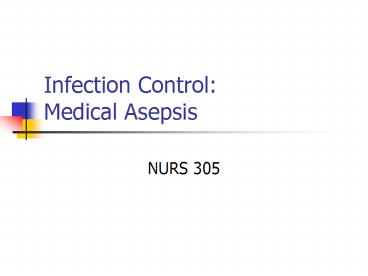Infection Control: Medical Asepsis - PowerPoint PPT Presentation
1 / 27
Title:
Infection Control: Medical Asepsis
Description:
nose, mouth, eyes, other mucous membranes, cuts in skin, dry or cracked skin ... Mucous membranes (lining of the mouth, nose, eyes, rectum, vagina) ... – PowerPoint PPT presentation
Number of Views:3414
Avg rating:3.0/5.0
Title: Infection Control: Medical Asepsis
1
Infection Control Medical Asepsis
- NURS 305
2
Asepsis
- Condition in which no infection is present the
absence of disease producing microorganisms - Types of Aseptic Techniques
- Medical
- Surgical
3
Medical Asepsis(Clean Technique)
- Examples
- Handwashing
- Using clean gloves to prevent direct contact with
blood or body fluids - Routine cleaning of the environment
4
Terms
- Pathogens Harmful microorganisms that cause
infection - Microorganism An organism of microscopic size
- Infections Occur when pathogens enter the body
5
Chain of Infection
- Describes how disease is transferred from one
living being to another
6
Chain of Infection Link One
- Causative agent
- a pathogen or microorganism that causes disease
- may be bacterium, virus, fungus or protozoan
7
Chain of Infection Link Two
- Reservoir
- place where the pathogen lives and grows
- lungs, blood, large intestine, etc.
8
Chain of Infection Link Three
- Portal of exit
- any body opening on infected person that allows
pathogens to leave - the nose, the mouth, the eyes, cuts in the skin
9
Chain of Infection Link Four
- Mode of Transmission
- how the pathogen travels from one person to the
next - through the air, direct contact, or indirect
contact
10
Chain of Infection Link Five
- Portal of entry
- any body opening on uninfected person that allows
pathogens to enter - nose, mouth, eyes, other mucous membranes, cuts
in skin, dry or cracked skin
11
Chain of Infection Link Six
- Susceptible host
- uninfected person who could get sick
- all healthcare workers and anyone in their care
who is not already infected with that particular
disease
12
Things to Remember
- If one of the links in the chain of infection is
broken, then the spread of infection is stopped
13
Body Substances Covered Under Standard Precautions
- Blood and blood products
- All body fluids, secretions, excretions, except
sweat (regardless of whether or not they contain
visible blood) - Broken skin (including acne and open sores)
- Mucous membranes (lining of the mouth, nose,
eyes, rectum, vagina)
14
Things to Remember About Standard Precautions
- Used on all patients regardless of their
infection status - Reduce the risk of bloodborne pathogen
transmission - Reduce the risk of disease transmission from body
substances
15
Guidelines When to Wash Hands
- Before and after using restroom
- After touching body substances
- Before putting on gloves
- After taking off gloves
- Before feeding patients
- Before and after meals
- Between all contact with patients
- Before leaving facility or home
16
Things to Remember
- Handwashing is the single most important thing
you can do to prevent the spread of disease
17
Guidelines When to Wear Gloves
- If you might touch blood
- When handling body fluids
- During mouth care
- During perineal care
- When shaving patient
- When providing personal care on broken skin
- When providing personal care if there are cuts on
your hands - When disposing of soiled linens
18
Guidelines When to Change Gloves
- Immediately before contact with mucous membranes
or broken skin - If gloves become soiled, worn, or damaged
19
Guidelines When to Remove Gloves
- After use
- Before touching non-contaminated items or
surfaces - Before caring for another patient
20
Guidelines When to Wear Gowns and Aprons
- During a procedure that is likely to cause body
fluid splashes or sprays - When appropriate for the procedure or activity
and the amount of fluid likely to be encountered
21
Guidelines When to Wear Masks, Eye Protection,
and Face Shields
- To protect facial mucous membranes during
procedures and activities likely to generate
splashes or sprays
22
Demonstration Washing Hands
- Turn on water at sink
- Angle arms down
- Wet hands and wrists
- Apply cleanser or soap
- Lather all surfaces of fingers and hands,
producing friction, for at least 10 seconds - Clean fingernails by rubbing in palm of other
hand - Dry hands
- Turn off faucet using paper towel
23
Demonstration Putting on Gloves
- Wash hands.
- If right-handed, slide one glove on left hand
(reverse if left-handed). - With gloved hand, take second glove and slide
other hand into it. - Interlace fingers to smooth out folds and create
a comfortable fit. - Carefully look for tears, holes, or spots.
Replace the glove if necessary. - If wearing a gown, pull the cuff of the gloves
over the sleeve of the gown.
24
Demonstration Taking Off Gloves
- Touching only outside of one glove, pull first
glove off by pulling down from the cuff. - As the glove comes off, it should be inside out.
- With ungloved hand, reach two fingers inside
remaining glove. - Pull down, turning glove inside out over first
glove. - Dispose of gloves.
- Wash hands.
25
Demonstration Putting on a Gown
- Open gown.
- Hold gown in front of you.
- Slip arms into sleeves and pull gown on.
- Tie neck ties into a bow.
- Reaching behind, pull gown to cover clothing.
- Tie the back ties.
- Use gown only once.
- Put on gloves after putting on gown.
26
Items to Clean and Disinfect
- All environmental surfaces
- Beds, bedrails, all bedside equipment
- All frequently touched surfaces (doorknobs are a
good example)
27
Guidelines Handling, Transporting, and
Processing Soiled Linens
- Prevent skin and mucous membrane exposure
- Prevent contamination of clothing (hold linen
away from uniform) - Prevent transfer of disease to other patients
environments































